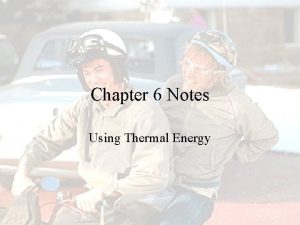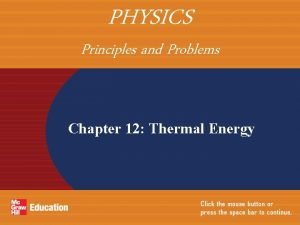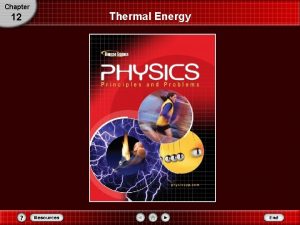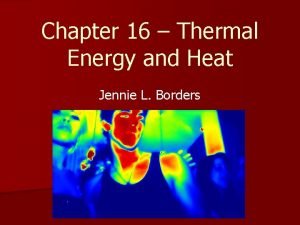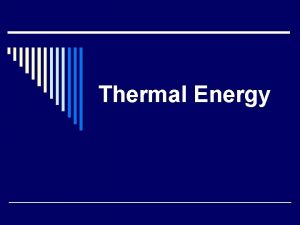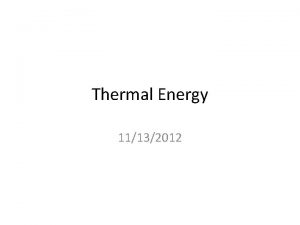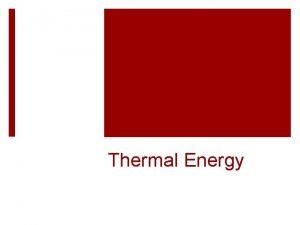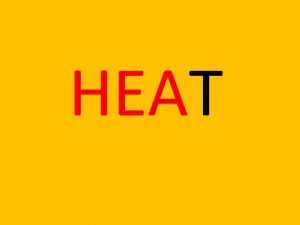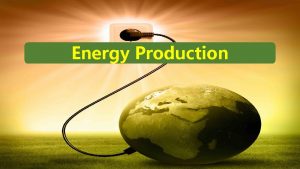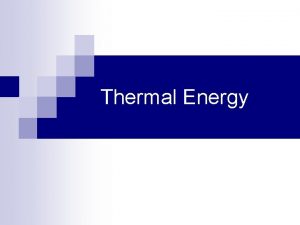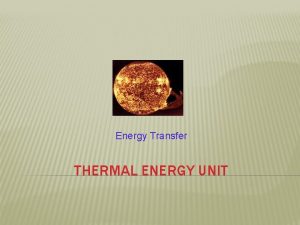Chapter 6 Notes Using Thermal Energy Thermal Energy









- Slides: 9

Chapter 6 Notes Using Thermal Energy

Thermal Energy on the “Moo”ve • Conduction- transfer of energy by direct contact of particles • Convection- transfer of energy by bulk movement of particles • Radiation- transfer of energy through waves.

Insulators • Good insulators do not allow heat to move easily through them. – Wood, plastic, glass, fiberglass, and gases such as air are excellent insulators. • Several insulating materials contain many tiny pockets of trapped air – Examples: » Styrofoam cups, down winter coats, fiberglass insulation.

Fluid • Fluid- anything that flows. • Yes, gasses are fluids too. • Solids are not fluids because they cannot flow.

Conventional Heating Systems • Radiator system: – Radiator- a device with a large surface area designed to heat the air near it by conduction. – Forced-air system- energy released in furnace heats the air. A blower is used. (pg. 163) – Electrical heating system- heating coils located within floors and ceilings are heated by electrical energy.

Solar Heating • Solar energy- energy from the sun. -It’s FREE!! 2 Types of Solar Heating Systems: 1. Passive Solar Heating- uses no fans or mechanical devices to transfer heat from one are to another. 2. Active Solar Heating- radiant energy is used to heat water that is then pumped throughout a house.

Using Heat to do Work • Heat engines – devices that convert thermal energy into mechanical energy. • Combustion – rapid burning of fuel. – Internal combustion engine – fuel burns inside the engine in chambers called cylinders. • Cars, trucks, etc. – External combustion engine – fuel is burned outside the engine. • Early locomotives

Heat Movers • Heat always flows from warmer to cooler areas. • Heat mover – a device that removes thermal energy from one location and transfers it to another location at a different temperature. – Example = refrigerators

Evaporation and Condensation • Evaporation is a cooling process. – When a liquid changes to a gas, energy is absorbed from the liquid’s surroundings. • What this means is that when you sweat, energy is released to the air around you, thus making you cooler. • Condensation is a warming process. – On humid days more water vapor is in the air around you. You sweat doesn’t evaporate as quickly, thus you don’t cool off as easily. • This is why you feel hotter on humid days.
 Thermal energy section 3 using thermal energy
Thermal energy section 3 using thermal energy Thermal energy notes
Thermal energy notes Thermal energy notes
Thermal energy notes Thermal energy vs heat energy
Thermal energy vs heat energy Kinetic energy to thermal energy
Kinetic energy to thermal energy Thermal transfer vs direct thermal printing
Thermal transfer vs direct thermal printing Chapter 12 study guide thermal energy
Chapter 12 study guide thermal energy Chapter 12 thermal energy answers
Chapter 12 thermal energy answers Chapter 16 thermal energy and heat
Chapter 16 thermal energy and heat Chapter 5 thermal energy
Chapter 5 thermal energy


